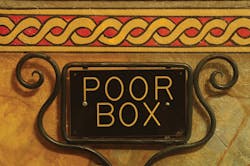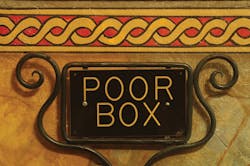LOW INCOME POPULATIONS
HOW THE GOVERNMENT FINANCES DENTAL CARE
CHRISTINE NATHE, RDH, MS
Looking back from a historical perspective, the financing of dental care was the responsibility of the patient in need of treatment and the dental practitioner who managed the dental practice. However, times have changed and the financing of dental care now involves numerous entities in both the private and public sectors. Over 40% of the U.S. population had dental care expenditures in 2008. Almost 92% of these expenditures were paid for by private funds, whether by the patient out-of-pocket (49.7%) or by private insurance (41.8%).1 Approximately 54% of the population had private dental coverage, 12% had public dental coverage only, and 35% had no dental coverage.2 This article will give a basic overview of current dental care support mechanisms.
FINANCING OF DENTAL CARE
One of the major changes that influenced the financing of dental care is the adoption of dental insurance by employers. Many employers offer dental insurance as a benefit or part of a salary package to employees. Although employees pay a premium for such an amenity, most routine, preventive dental services are exclusively covered by dental insurance. This has been a tremendous triumph for dental hygiene, since it is proof that the practice of prevention is logical in health care delivery.
However, many agree that funding of dental care has become a real issue for many Americans. Although many discuss the need for solutions, funding for preventive dental care outside of the private sector has not been realized to its full potential. Dental caries continues to be one of the most common chronic diseases of childhood, and in the U.S., one in four adults 65 and older have lost all their teeth.3
As dental hygienists can attest, prevention is paramount in dental care issues and is a key factor when preventing infection and pain. Low income Americans of any age are more likely than high income Americans to have oral health problems.4 Children living below the poverty line are twice as likely as their affluent peers to suffer from toothaches, and the likelihood of experiencing this pain is even greater for children with special needs.5
FEDERAL INFLUENCE
In the U.S., the federal, state, and local governments' share of expenses for dental care overall is growing.6 Basically, the federal government provides funding for dental care delivery in a variety of programs for the purpose of improving the nation's capacity to provide improved oral health care. The government funds programs that provide research, control water fluoridation, provide fluoride mouth rinse programs and dental sealants in schools, regulate by means of quality assurance programs and assessment, and educate dental professionals via scholarships, financial aid, and loan forgiveness programs (programs in which you practice dental hygiene in underserved communities for a specified time commitment).7
The federal government provides funding to organizations that are focused on providing dental services to specific populations, such as the U.S. Public Health Service and the National Health Service Corps. Additionally, the federal government funds dental services for federal prisoners, military personnel, veterans with dental service-connected disabilities, and Native Americans and Native Alaskans via the Indian Health Service.
Federal block grants may cover some dental services, especially for children. A block grant is a large sum of money the federal government gives to a state or local government with general provisions as to how it is to be spent. The Maternal and Children's Health Services (MCHS) Block Grant Title V and Preventive Health and Human Services are usually used as preventive block grants and may cover dental services for children.8
Many dental clinics use federal and state grants to cover operational costs. Dental treatment for children with craniofacial deformities, cleft lip and palate, and certain other conditions is funded by state and federal money. In some states, dental hygiene services are offered to people participating in the Women, Infants and Children Program (WIC).
MEDICAID AND CHIP DENTAL COVERAGE
The federal government also funds dental services via Medicaid and provides limited funding for medically necessary dental services, such as oral/maxillofacial needs related to a medical condition. Medicaid is a federal program enacted in 1965 that distributes funds to states for the provision of health care services to the low-income population. Dental care is an option, depending on the state, and requires additional funding from the state.
Each state decides whether to offer Medicaid dental insurance as a traditional fee-for-service plan or a capitation agreement. In many states, Medicaid insurance is operated by private insurance agencies.7,9
Because the federal government gives states the freedom to apply federal money in many ways, Medicaid dental benefits differ from state to state. For instance, some states provide coverage solely to children under the age of 21, while other states choose to insure all low-income individuals, regardless of age. If a state limits coverage to children, more money is available to spend on each child and the state is able to pay providers usual, customary, reasonable (UCR) rates. States may also choose this option because, theoretically, more providers would be motivated to see children covered by Medicaid insurance when fees are comparable to fees paid by most dental insurances. However, when only children are covered, many other people are left with no dental coverage.7,9
Although many states fund dental care to the low-income population through Medicaid, that population may have difficulty accessing dental care. Many dental practitioners choose not to enroll as Medicaid providers, citing such factors as frequently missed appointments, difficult treatment issues, low reimbursement rates, and too much bureaucratic paperwork. This can tremendously affect access to care for these patients.7
Signed into law in 1997, the Children's Health Insurance Program (CHIP) - initially referred to as the State Children's Health Insurance Program (SCHIP) - provides health care coverage to nearly 8 million children from families with incomes too high to qualify for Medicaid, but who cannot afford private coverage. Like Medicaid, CHIP is administered by the states, but is jointly funded by the federal government and states. Every state administers its own CHIP program with broad guidance from Centers for Medicare and Medicaid (CMS).
State options for designing the CHIP program are in one of three ways:
1) Medicaid expansion (seven states, D.C., and five territories)
2) Separate Child Health Insurance Program (17 states)
3) A combination of the two approaches (26 states)10
STATE GOVERNMENT INVOLVEMENT
State governments generally fund dental services for inmates of state prisons and detention centers. Many times the state may contract with a private agency to deliver dental services. The state dental departments may provide consulting skills for developing and managing dental health programs. In some states, state dental clinics offer services to a target population, which usually includes children, patients with special needs, older adults, and patients with low incomes.7
LOCAL INVOLVEMENT
Local governments may provide dental care in schools or community clinics. In many instances the funding for these clinics is derived from federal, state, private, and local government entities. Funding for water fluoridation usually falls under the auspices of local government.
Often educational programs involve state funding for dental hygiene programs and dental schools. These endeavors may also include federal grants and scholarship monies. Dental hygiene and dental school clinics are another avenue for providing the community with low-cost dental services.
Often faith-based initiatives funded by community members provide volunteer clinics in communities to serve as a safety net for those in need of dental care who do not have the ability to pay for services. These initiatives spotlight grassroot efforts of a community.
Many times, those in extreme pain feel the absence of preventive care. These individuals access local emergency rooms and, in some instances, end up in an operating room with severe infections stemming from untreated dental disease. Funding comes from various sources in these cases, and may involve local, state, and federal sources.
Most dental care in the U.S. remains in the private sector. However, federal, state, and local governments are involved in funding dental care to certain populations. The government also funds dental research and education of dental providers. Dental insurance plans have made preventive dental care affordable to those who are enrolled, and have focused on prevention as a means to decrease restorative dentistry costs. In order to become consumer advocates, dental hygienists must understand dental funding in both private and public organizations.
REFERENCES
1. Rohde F. Dental Expenditures in the 10 largest states, 2008. Statistical Brief #353. December 2011. Agency for Healthcare Research and Quality, Rockville, Md.
2. Manski RJ, Brown E. Dental use, expenses, private dental coverage and changes, 1996-2004. Rockville, MD: Agency for Healthcare Research and Quality; 2007. MEPS Chartbook N.
3. Sanders G. Dental Crisis in America: The Need to Expand Access. A report from Chairman Bernard Sanders. Subcommittee on Primary Health and Aging. U.S. Senate Committee on Health, Education, Labor and Pensions. February 29, 2012.
4. Centers for Disease Control and Prevention [CDC]. Oral Health: Preventing Cavities, Gum Disease, Tooth Loss, and Oral Cancers; 2011. http://www.cdc.gov/chronicdisease/resources/publications/aag/pdf/2011/Oral-Health-AAG-PDF-508.pdf.
5. Lewis C, Stout J. "Toothache in U.S. Children." Archives of Pediatric Adolescent Medicine, Vol.161, No. 11, 1059-1063; 2010.
6. The future of dentistry retrieved from http://www.dentaleconomics.com/articles/print/volume-95/issue-9/features/the-future-of-dentistr0y.html on July 9, 2012.
7. Nathe CN. Dental Public Health and Research, 3rd Edition. Upper Saddle River, NJ: Pearson, 2011.
8. Title V Maternal & Child Health Block Grant Program Technical Assistance Resources. Retrieved from http://mchb.hrsa.gov/grants/titlevtechnicalassistance.html on June 8, 2012.
9. Medicaid. Retrieved from http://www.cms.hhs.gov/home/medicaid.asp on http://www.cms.hhs.gov/home/medicaid.asp on June 7, 2012.
10. State and Federal Funding for CHIP. Retrieved from http://www.medicaid.gov/Medicaid-CHIP-Program-Information/By-Topics/Childrens-Health-Insurance-Program-CHIP/Childrens-Health-Insurance-Program-CHIP.html on June 8, 2012.
CHRISTINE NATHE, RDH, MS, is a professor and graduate program director at the University of New Mexico, Division of Dental Hygiene, in Albuquerque, N.M. She is also the author of "Dental Public Health Research" (www.pearsonhighered.com/educator), which is in its third edition with Pearson. She can be reached at [email protected] or (505) 272-8147.

